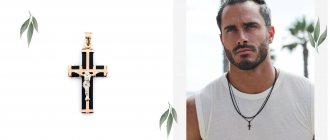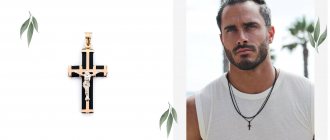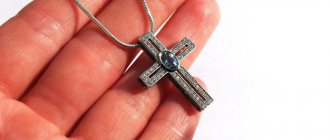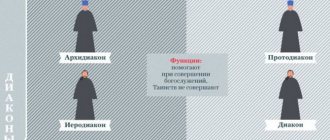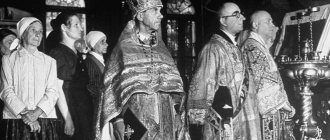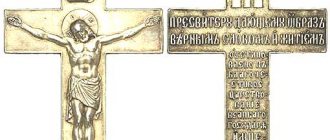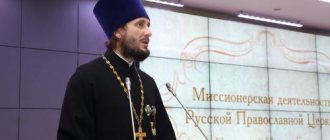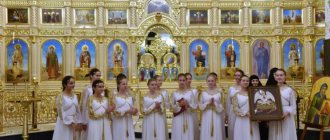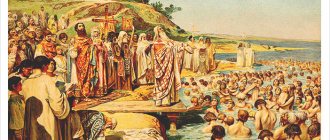Questions and answers. Orthodoxy in detail
Question: “Once my pectoral cross fell out, and they told me that it was Catholic, because... it is without the Crucifix and the inscription “save and preserve.” Now I’m tormented by doubts: is it possible to wear such a cross?”
Archpriest Dmitry Smirnov answers: “It’s possible. I also wear a cross on my body without the inscription “save and preserve.” What does “is it possible or not” mean? Who can stop you anyway? What is this fear of stupid people - it is possible, it is not, where is it written? Say: “Give me a Church decree - ancient or new.” There must be a paper - a Resolution of the Holy Synod, or a Council of Bishops, or simply even a decree of the Patriarch. It's enough." O. Alexander: “About the shape of the Cross.” O. Dmitry: “No, but the Cross is Greek. The four-pointed Cross was always called Greek. Moreover, even if you look at the priestly Crosses, all of them, with rare exceptions, have an image of a four-pointed Cross on them. Then - Catholic. There is no Catholic Cross; the Cross is exclusively that of Christ, on which Christ was crucified. As for what tradition it was made in, it doesn’t matter at all. So, there is nothing to be embarrassed about here. And many people, especially those who were unable to raise their children in the Orthodox faith, make up for it by trying to teach young people, and since they know neither the Gospel, nor the teachings of the Church, nor the history of the Church, nor its canons, they they themselves make up all sorts of “it’s possible, it’s not”, for example - you can’t pass a candle over your left shoulder - that’s one of these crazy wishes, and they came up with a lot of things like that, “you can’t put a candle upside down” - where they find the legs of a candle, for me, for example , is still a mystery. And today I read one confession. I'll tell you the secret of confession. One servant of God writes (and I talk about this in every sermon about Lent, and she is our constant parishioner) that she sinned: “On Wednesday I ate ice cream, and asked the saleswoman if it was Lenten? The saleswoman said: “Lean”, they asked if there was milk there, the saleswoman said: “No”, then she came home and looked at the ice cream with a magnifying glass, and through the magnifying glass she found milk there.” So, finally, this poor sinner woman found something to repent of. Although we don’t talk about milk, and about cottage cheese pancakes, and about everything else during the sermon about Lent, and all the time. So our life is very difficult. But, if they pester you very much, it’s a wooden cross, well, take it and write there: “Save and preserve.” And I’ll tell you a secret - besides Russia there are several more Orthodox countries, and in these countries people also wear Crosses, and nowhere except Russia you will find Crosses with the inscription “Save and Preserve.” Patriarch Philotheus recently came; if he has a cross on his body, then there is no inscription on it: “Save and preserve.” And the tradition of writing this inscription generally arose only in recent years.”
What should the pectoral cross of the Russian Orthodox Church look like?
no comments
Is there such a thing as a correct Orthodox cross? Surprisingly, debates about this have been going on for a very long time - almost since the appearance of this important Christian symbol. Most often, this question is asked by people who are faced with the need to purchase a pectoral cross, and for whom this piece of jewelry means more than just a beautiful decoration.
In order to figure out what shape an Orthodox cross should be and what symbols should be depicted on it, let’s turn to history and find out what meaning is hidden in this sign of a follower of Christ, which has already become so familiar. The first predecessors of the pectoral cross appeared immediately after the Resurrection of Christ - these were medallions with the image of the living Jesus, as well as the Lamb - the Old Testament prototype of the Son of God. About three centuries later, pectoral crosses without the Crucifix appeared - this is due to the fact that it was during this period of time that the Cross of Christ was discovered in Jerusalem.
Orthodox pectoral cross of the correct shape: what to look for when buying
After the Cross of Christ began its victorious march across the planet, the shape of the pectoral cross was repeatedly changed and improved. So many symbols and signs that are considered canonical have survived to our time that one could write not an article, but a dissertation about them. There is no single form of a correct Orthodox cross on the neck: a great variety of them have appeared over two millennia, so let’s pay attention to those details that ideally should not be on the canonical cross.
- The sagging figure of Jesus Christ is a typical sign of a Catholic or Latin cross. On the correct pectoral Orthodox cross, the silhouette of the Savior is, as it were, superimposed on top of the Crucifixion; there is no sign of human suffering in Him.
- Jesus' feet on the cross should not be nailed with one nail. They are located side by side and each depicts a separate nail.
- It should not contain any symbols, prayers or inscriptions related to other Christian denominations and, especially, religions.
All of the above is especially important to take into account when making handmade gold crosses, because even the most skilled jeweler may not fully understand the intricacies of the Orthodox canon.
Which is better to choose a pectoral cross without a Crucifix or with a Crucifix?
The difference between these two types of Orthodox crosses is most obvious. Many people think that Orthodox crosses without the Crucifixion are “wrong,” but this, of course, is not the case; on the contrary, they are a more ancient and authentic version of the pectoral cross.
On a correct pectoral Orthodox cross without an image of the Crucified Jesus, there can be an image of Christ Pantocrator, the faces of the Mother of God and saints, just a symbolic cross or various ornaments - this does not make it any less correct and grace-filled.
What is crucifixion?
Execution on the cross was the most terrible execution invented by ancient man. The crucified body sagged on the cross in such a way that its fulcrum was in the chest. When a person's arms are raised above shoulder level and he hangs without supporting his legs, the entire weight of the upper half of the body falls on the chest. As a result of this tension, blood begins to flow to the muscles of the pectoral girdle and stagnate there. The muscles begin to gradually become stiff. Then the phenomenon of asphyxia occurs: the pectoral muscles, cramped, compress the chest. The muscles do not allow the diaphragm to expand, the person cannot take air into the lungs and begins to die from suffocation. Such execution sometimes lasts several days. Birds peck out the eyes of people who are still alive, stray dogs eat their toes...
Still from the film “The Passion of the Christ”, 2004 Photo Poster. RU
Forged faceted nails were driven between the radial bones of the arm, next to the wrist. On its way, the nail met a nerve ganglion, through which the nerve endings go to the hand and control it. The nail interrupts this nerve node. In itself, touching an exposed nerve is a terrible pain, but here all these nerves are broken. But not only is there only one way out to breathe in this position - you need to find some kind of support point in your own body in order to free your chest for breathing. A nailed person has only one possible support point - these are his legs, which are also pierced in the metatarsus. The nail goes between the small bones of the metatarsus. The person should lean on the nails that pierced his legs, straighten his knees and raise his body, thereby relieving the pressure on his chest. Then he can breathe. But since his hands are pierced with nails, they begin to rotate around the nail. To breathe, a person must turn his hand around a nail, which is by no means round and smooth, as it is now, but completely covered with sharp jagged edges. This movement is accompanied by pain on the verge of shock.
The Gospel says that the Savior suffered on the Cross for about six hours. To speed up the execution, the guards or executioners broke the legs of the crucified man with a sword. The man could not rise to his feet to breathe, and quickly suffocated. The Gospel reports that the guards broke the legs of two robbers, but Christ died Himself, and died from a broken heart, which is proven by the message about blood and pericardial lymph flowing out of the broken chest. Christ died of a broken heart, because in addition to physical suffering He endured terrible mental anguish: He bore the sins of all mankind.
So, let me remind you, we talked about why a footstool, a lower crossbar, was needed on the cross.
A man condemned to death stood on it, leaning on it with his pierced legs, pulling himself up to take a life-giving breath of air.
...This is precisely the meaning of the crossbar in the early images of the Cross of Christ, but gradually other symbolic meanings of this crossbar appear.
According to Byzantine ceremonial, the foot signifies the greatness of the person depicted. Therefore, in ancient images of the cross, the foot had a cubic shape and was similar to the foot depicted on the icons at the Throne of the Almighty, thereby showing the Savior on the Cross as the King of Glory.
Gradually, from the tenth century, the volumetric cubic base in Byzantine and Russian art turned into a wide board. In Russian crosses from the 15th to 17th centuries, it begins to be depicted with the right end beveled upward.
A special interpretation also appears. As we remember, two thieves were crucified on both sides of the Cross of Christ. One of them blasphemed the dying Lord, the other asked: “Remember me, Lord, in Your Kingdom.” The crossbar with its end up points to the “prudent” robber (on the right, so the right side of the Cross is directed upward), and with its end down, it points to the robber who blasphemes the Lord.
Calvary cross without crucifix. The meaning of symbols and inscriptions.
May 23, 2020
In Orthodoxy, the symbol of the cross carries a deep spiritual meaning. It symbolizes the self-sacrifice that Jesus made for the sake of all mankind, giving hope for salvation and eternal life. The cross can be depicted in various forms, some have a crucifix with the body of Christ, there are crosses without a crucifix, but each carries a unique spiritual meaning. The Calvary cross is one of the oldest designs of the cross. These are the crosses that Old Believers use.
The image of the Calvary cross is familiar to everyone; we see it on the clothes of priests, on temple dishes, on body crosses, on icons. It encrypts the whole story of a great event that changed the entire history of the world.
The cross depicts the cross itself on which Christ was crucified, Mount Golgotha on which the execution took place, the Head of Adam - a skull located in a cave inside the mountain, instruments of execution, as well as inscriptions that explain the picture of the crucifixion.
The Calvary cross is made eight-pointed in memory of Christ's crucifixion, or the image of the eight-pointed Calvary cross is inscribed in the traditional four-pointed cross. The cross itself consists of a vertical beam and a wide board placed on it at a height of just over two-thirds.
Above the horizontal beam and parallel to it is a short board, such as was nailed to the instrument of execution before it began, with the text inscribed by Pontius Pilate “Jesus of Nazareth, Ruler of Judea.” All Christian Calvary crosses have the same text, only in Church Slavonic.
At the bottom of the cross there is a short board placed diagonally, a conventional pedestal, nailed after the crucifixion. These are symbolic scales of human sins. Her right side is slightly higher than her left. The Holy Scriptures say that two criminals were executed on either side of Jesus. And the one on the right repented and received salvation and eternal life, while the other one on the left found himself eternal suffering.
The cross is depicted at the foot, symbolizing Mount Golgotha. Golgotha, literally translated as “skull,” is referred to in the Holy Scriptures as “Place of Execution.” On crosses it is depicted as a hill or a pyramid, or as three steps. Moreover, the steps also have special meanings: the bottom one is called Faith, the middle one is Love, and the top one is Charity.
Nearby there are two letters “GG” - “Mount Golgotha”, as well as “ML” - “Place of the Execution” and “RB” - “Paradise will be”.
Under the hill there is a skull - “the head of Adam”. The letters “G” and “A” are placed nearby. Adam's skull, washed with the blood of the crucified Jesus, symbolizes the sins of mankind, which were atoned for by the Son of God at the cost of his life. According to one version, Adam's skull appeared in the caves of Golgotha as a result of the Flood, according to another, Adam was originally buried here.
On both sides of the cross there is always a Spear and a Cane with a sponge at the end - symbols of the torture and torment that Jesus underwent in order to cleanse people from sins. They are O's and T's.
The body of Christ is not on the schematic representation of the cross; it is indicated by the monograms “Is Xc” - Jesus Christ next to the wide crossbar.
Above the eight-pointed cross is the inscription “King of Glory,” which symbolizes that with his life and death Christ acquired all earthly glory.
At the top of the cross it is also customary to write “Son of God,” which shows the divine nature of the Savior.
The cross must have the inscription “NIKA”, which means “defeated”, “victory”. With this word Jesus rose again.
Such a visual image of the execution of the Savior, which is the Cross of Calvary, has become the most popular and revered symbol of Christianity. It is applied as a pectoral cross, it is a relic and a particle of the Lord's Grace, and it is not at all only a sign of monks, clergy or a cemetery. And it doesn’t matter what material the cross is made of, silver, gold, wood or other materials.
You can purchase Calvary crosses in our store.
Return to list of publications
cross without crucifix
God-parents
Who are godparents? The sacrament of baptism is a special rite. This is the purification of the soul and the spiritual birth of a person. According to the tradition of the Church, an infant should be baptized on the eighth or fortieth day of life. It is clear that at this age it is impossible to demand from him faith and repentance - the two main conditions for union with God. Therefore, godparents are assigned to them, who undertake to raise their godchildren in the spirit of Orthodoxy. So the choice of godparents should be approached with all responsibility. After all, in theory, they should become a second mother and a second father for your baby. How to choose godparents? When choosing a godfather for your baby, find someone you trust completely. These could be your close friends or relatives with whom you constantly maintain good relationships. According to church tradition, if something happens to the parents, godparents are obliged to replace them with a godson. Only an Orthodox believer who is able to give an account of his faith can be a godfather. Actually, a boy needs only a godfather, and a girl only needs a godmother. But according to the ancient Russian tradition, both are invited. According to your desire, there can be two, four, six of them... According to the laws of the Orthodox Church, the following cannot be godfathers (godparents): parents cannot be godparents of their child; husband and wife godparents of one infant; children (according to the decrees of the Holy Synod of 1836-1837, the godfather must be no younger than 15 years old, and the godmother no younger than 13 years old), because they are not yet able to vouch for the faith of the person being baptized, and they themselves do not know enough about the laws of Orthodoxy; people are immoral and insane: the former because their very way of life does not deserve to be godparents, and the latter because, due to illness, they are unable to vouch for the faith of the person being baptized or teach him the faith; the non-Orthodox are the successors of the Orthodox.
What are the responsibilities of godparents?
Unfortunately, not every godparent understands why his new “position” is called that way. Visiting your godson and giving gifts on an angel’s or birthday day is, of course, good. However, this is far from the most important thing. Caring for a growing godson involves a lot. First of all, this is a prayer for him. Learn to turn to God once a day - before going to bed. It's actually not difficult at all. Ask the Lord for health, salvation, help in raising your own children, the well-being of godchildren and relatives. It will be useful to master the path to the temple together with your child and take him to communion on a church holiday. It would be great to play educational games with your baby and read books to him. For example, many adults enjoy reading the children's Bible. It clearly describes all the main events of Sacred History. In addition, godparents can make life much easier for young mothers who find it difficult to find time to spend with their baby. If everyone, to the best of their ability, spends their free hours communicating with the child, then they themselves will enjoy it.
Appearance of godparents
At the ceremony, the recipients (this is another name for the godfather) must come with pectoral crosses consecrated in the church. In the traditions of the Slavic peoples, women in the temple always had a covered head and a dress below the knees with covered shoulders (little girls may be an exception). You should not wear high-heeled shoes, as the baptism ceremony lasts from 30 minutes to 2 hours and most of the time you will have to stand with the child in your arms. As for men, there are no requirements for their clothing, but it is better to refrain from shorts and T-shirts. Such an outfit would look out of place in church. Don't let the good old ways become a burden for you, because your nice trousers and new fashionable haircut can be shown off in other places. In church, it is better not to attract attention to yourself, focusing on the purpose of your parish.
Preparation for the ceremony
Currently, the ritual is performed mainly in churches. Only in exceptional cases, if, say, a child is very ill, can the sacrament be performed at home or in a hospital. Then a separate clean room must be allocated for the ceremony. To baptize a child, you must first choose a church. Walk through the temples, listen to your feelings. But keep in mind that baptism does not always take place directly in the church. Most cathedrals have a baptismal chamber (or baptistery) - this is a separate room on the church grounds, specially adapted for this rite. In large churches, baptism usually takes place quite pompously and solemnly. But perhaps someone will like the secluded and calm atmosphere of small churches. Talk to the priest or the novices, they will tell you in detail about how the baptismal ceremony takes place in this church.
How to choose the day of baptism
?
There is no church establishment of Baptism on the fortieth day; this is primarily due to the fact that until the fortieth day the Church keeps a woman-parent from entering the temple due to her postpartum infirmities and discharges that she experiences at this time. And the mother’s first entry into the temple after the break is accompanied by the reading of special cleansing prayers, before reading which she should not be present at the services. But you don’t need to take the day of baptism literally; you can baptize the baby a little later, a little earlier. And now sometimes, at the request of the parents, a child is baptized before the fortieth day, especially when there is at least some danger to the child’s health (baptism in this case is considered as a protective rite). In ancient times, the celebration of the sacrament was most often timed to coincide with the greatest Christian holidays, for example Easter. But gradually baptism turned into a family holiday. And now, on the contrary, the ritual is carried out almost every day, with the exception of such major church holidays as Christmas, Easter, Trinity. These days, churches are usually overcrowded and priests advise postponing the ceremony. You can come to most temples without an appointment. Usually the sacrament of baptism begins at 10 o'clock, immediately after the service. True, in this case there is a high probability that several other people will be baptized besides you and you will either have to wait, or you will be baptized along with others. It is much more convenient to agree in one or two weeks with the priest who will perform the sacrament on a specific date and time. Then your baby will be baptized first and in splendid isolation. In addition, when choosing the day of baptism, try to ensure that it does not fall on the godmother’s critical days. The fact is that during this period a woman should not venerate shrines: kiss the cross, icons, or better not enter the temple at all.
Preparing godparents for the baptismal ceremony
If you want to follow all the rules, start preparing for the ceremony in advance. Godparents need to go to church to confess, repent of their sins and receive communion. It is advisable (but not necessary) to fast for three to four days before the ceremony. But on the day of baptism, as well as before communion, godparents are not allowed to eat or have sex. At least one of the parents must know the “Creed” prayer by heart. As a rule, when a girl is baptized, the Creed is read by the godmother, and when a boy is baptized, by the father. And one more thing: according to the unspoken rule, godparents bear all the costs of baptism. In some churches there are no official prices; it is believed that after the ceremony, godparents and guests make donations as much as they can. These costs are optional and their amount is not specified anywhere. But the custom is, as a rule, respected. According to church custom, the godmother buys the kryzhma or “rizka”. This is a special fabric, or just a towel, in which the child is wrapped when taken out of the font. In addition, the godmother gives a baptismal shirt and a cap with lace and ribbons (for boys - with blue ones, for girls - with pink ones, respectively). The baptismal shirt is kept for life. According to custom, the towel is not washed after the child’s baptism, but is used if the child is sick. The godfather, again according to custom, buys a baptismal cross and chain. Some believe that the cross and chain should be gold, some - silver, and some are of the opinion that small children should wear a cross on a ribbon or string.
What prayers do you need to know?
Every conscientious Christian needs to know the basic prayers: “Our Father”, “Virgin Mother of God”, “Creed”. During baptism, the godparents say the “Creed” prayer for the baby. All these prayers are in a short prayer book, which can be purchased at the church store if desired. What to bring to the temple? As already mentioned, baptism is birth into a new sinless life. Receiving the newly baptized person from the holy font, the godparents accept an absolutely pure being, without sin. A symbol of such purity is white clothing - kryzhma, which is brought to the temple along with a cross on a chain or thread. Who should buy a cross and who should buy a chain, let the godparents decide for themselves. At the end of the ceremony, the priest will bless them and put them on the baby. The cover for a small child will be an openwork diaper, a baptismal shirt or a new towel that has not yet been washed.
What happens during the sacrament of baptism?
The priest, godparents and child are the main participants in the sacrament. According to ancient customs, the child’s mother and father should not be present when the sacrament is performed. Although recently the church has been more loyal to this prohibition and allows the father, and sometimes the mother of the baby, after saying a special prayer, to observe the ceremony together with those invited. Throughout the entire ceremony, the recipients stand next to the priest and one of them holds the person being baptized in his arms. Before performing the ceremony, a priest in white robes walks around the baptismal room or temple and reads three prayers. After which he asks the godparents and godson to turn their faces to the west - symbolically this is the abode of Satan. And, turning to the person being baptized, he asks several questions. Questions and answers are repeated three times. After this, the godparents must read the “Creed” - this is a brief summary of the fundamentals of the Christian faith, which all Orthodox Christians must know by heart. Then the anointing takes place. Having dipped the brush into a vessel with myrrh, the priest anoints the forehead, eyes, nostrils, mouth, ears, chest, arms and legs of the person being baptized with a cross. And with each anointing he says: “The seal of the gift of the Holy Spirit. Amen". The godparents and the priest repeat: “Amen.” After anointing, a lock of hair is cut from the head, which remains in the temple as a pledge of dedication and a symbol of sacrifice to God. If a child is being baptized in the cold season or conditions do not allow him to undress (low temperature in the baptism room), free the baby’s arms and legs in advance. Then the priest takes the child from them and directly performs the rite of baptism - immersing the person being baptized three times in the font. If the baptismal room is warm, then most likely your baby will be dipped naked. But when it is cold in the temple, only the neck, arms and feet are exposed for anointing. Then one of the godparents takes the baby from the hands of the priest. That is why godparents are also called godparents. It is believed that, having accepted the baby in their arms after the ceremony, parents undertake the obligation to raise their godson in the Orthodox spirit throughout their lives and to be held accountable for this upbringing at the Last Judgment. If they cannot see their godson often, they should at least mention him in their daily prayers. I believe in one God, Prayer is the Symbol of Faith of the Father, the Almighty, the Creator of heaven and earth, of everything visible and invisible. And in one Lord Jesus Christ, the Son of God, the Only Begotten, begotten of the Father before all ages: Light from Light, true God from true God, begotten, not created, one being with the Father, by Him all things were created. For the sake of us people and for the sake of our salvation, He came down from heaven, and took flesh from the Holy Spirit and the Virgin Mary, and became human. He was crucified for us under Pontius Pilate, and suffered, and was buried. And rose again on the third day, according to the Scriptures. And ascended into heaven, and sits at the right hand of the Father. And He will come again with glory to judge the living and the dead; His Kingdom will have no end. And in the Holy Spirit, the Lord, the giver of life, who proceeds from the Father, worshiped with the Father and the Son, and glorified, who spoke through vices. Into one, holy, catholic and apostolic Church. I recognize one baptism for the forgiveness of sins. I look forward to the resurrection of the dead and the life of the age to come. Amen.


